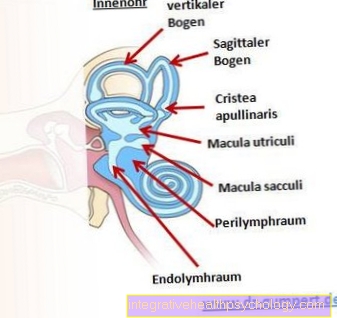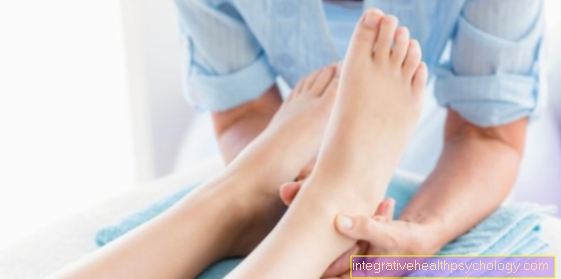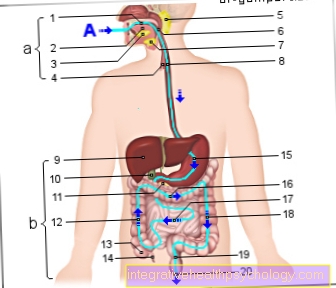Shingles on the legs
introduction
Under the disease Shingles you may not be able to imagine that much at first. Unfortunately, this disease is not as romantic as it sounds. If you ask around, one person might associate it with the upper body, the other might associate it with the face. What is it exactly and can you get shingles elsewhere, for example on leg?

definition
In medical terminology, the Shingles as Herpes zoster or Called zoster infection. It is about a Viral diseasethat their symptoms are on the skin shows, however, a disease of the associated Nerve is. When nerves that supply the leg are affected, shingles occurs on the leg.
What are the first signs of shingles?
The first signs of shingles, like those on the chest or stomach, are a general feeling of illness and a fever. Soon after, the typical skin problems appear, which can affect one to three band-shaped skin areas and are usually only found on one side of the body. These include severe pain as well as a tingling sensation and an increased sensation of pain when touching the diseased skin area. About four days after the onset of pain, a reddish rash and small, dense vesicles follow. The diseased skin area on the leg does not follow the typical horizontal borders as on the chest and stomach, but runs as a strip sloping from the side of the leg to the inside. Paralysis rarely develops in this skin area.
Symptoms of shingles on the leg
Especially in the leg, these symptoms may initially be confused with lumbago or a herniated disc of the lumbar spine. At the same time, however, a slightly increased temperature can be measured, and less often a fever.
After a few days, the skin symptoms of herpes zoster appear. It starts with the appearance of small fluid-filled blisters on reddened skin. Later on, the vesicles become cloudy, burst and form extensive crusts. When the vesicles burst, the pain usually also disappears. It is rare for the blisters to bleed or for the affected skin to die and turn black (necrosis). As a rule, shingles will heal after 2 to 3 weeks.
Read more about pain associated with shingles here.
itching
Itching is actually a form of pain. In shingles, it can appear right at the beginning together with the stabbing pain and tingling sensations, or later together with the rash and blisters. He should also be treated, otherwise the patient will tend to scratch open the blisters. In this way, they distribute the highly contagious contents of the vesicles on the body or transfer it to others. Children who have not been vaccinated, as well as adults who have not yet had to suffer from chickenpox, can become infected and develop chickenpox.
Numbness
Shingles is an inflammation of the nerves. This irritation results in pain, rarely paralysis and numbness. The numbness results from damage to the nerve lines caused by the virus and usually occurs during the acute phase of the disease. As a rule, no lasting numbness is to be expected, as these subside after the shingles. For this reason, no therapy is given in this regard.
Nerve pain
The inflammation and irritation of nerves caused by the virus can cause severe pain or tingling in the affected skin area. When it comes to pains in connection with shingles, a distinction must be made between those that develop during the course of the disease and soon subside, and those that extend well beyond the blistering and rash phase.
The latter is called "post-zoster neuralgia". They either go beyond the illness for more than four weeks or only appear four weeks after a pain-free interval. Older people in particular are often affected by this long-term consequence. They are characterized by piercing attacks in addition to the constant pain and pain to touch, which also occur during the illness. Both pains should be treated with comprehensive therapy.
Read more on this topic at: Nerve pain in the back
What is the course of shingles on the leg?
If you describe the course of shingles, you should start with the first infection. The future patient often gets through chickenpox in childhood. This is caused by the herpes zoster virus that settles in the nerve roots after the disease has subsided. It often remains there for many years without an outbreak.
Often in older adults or after a weakened immune system, the virus ignites a new infection. It spreads along the nerves, causing pain, numbness, tingling, paralysis, a rash and blisters. This re-infection is called shingles. Unfortunately, especially in older people, it is not uncommon for permanent pain to occur even after shingles.
For several years now, children can be protected with a chickenpox vaccine. Nevertheless, it is assumed that they too can develop shingles due to the vaccination. However, one assumes fewer diseases and milder courses. The future will show this more precisely.
For more information, read How Long Does Shingles Last?
Can it lead to paralysis?
In contrast to pain and tingling sensations, paralysis in shingles is rare, but it can happen. They are the result of damage to the nerve conduction pathways, which mostly affects the sensory nerves, and rarely also the motor nerves. As a rule, however, these regress completely after the illness. In some cases, however, the problem can persist.
Causes of shingles on the leg
Shingles is caused by the varicella-zoster virus, which belongs to the herpesvirus family (human herpesvirus-3). When infected for the first time, this virus causes the well-known chickenpox. This often happens in childhood and usually heals without complications.
The varicella zoster virus remains in the body and nests in the so-called ganglia. A ganglion is a nerve node, a switching station outside of the central nervous system (brain and spinal cord). The nerve cell bodies sit in them, the extensions of which then form the nerve. Humans have ganglia along the spine and in the head. The varicella-zoster virus often lies dormant in these ganglia for life. But is someone exposed to certain triggering factors, such as Stress or a weakened immune system can cause the virus to become active again. Each nerve supplies a skin area (so-called dermatome), which is clearly delimited and is only assigned to it. When the virus is reactivated, it spreads from the ganglion along the nerve and attacks the dermatome that is supplied by this nerve.
The leg is supplied by the nerves from the lumbar and sacrum spine and is divided into sections L1-L5 (L = loin) and S1-S5 (sacrum = sacrum). Associated dermatomes on the leg are supplied from each section and extend in strips from the groin to the foot. If a patient now has shingles on their leg, the affected region can be used to determine which ganglion is affected in which section.
Read more about the cause of shingles here.
It is important that the shingles is not necessarily contagious. The varicella-zoster virus is transmitted, which causes chickenpox upon first contact. If you have already been infected with chickenpox, you are immune to re-infection. The occurrence of shingles as a second disease, on the other hand, only depends on the immune status of the respective person. Children who have not yet had chickenpox and have not received a vaccination against it should, however, be kept away from zoster patients, as they can very well become infected and then get chickenpox.
Read more about "Is shingles contagious?"
Frequency distribution
Get sick every year 350,000 - 400,000 people in Germany from shingles. About two thirds of them are over 50 years old. Age is due to the decreasing performance of the body's immune system the biggest Risk factor.
Immune system disorders, such as an infection with HIV, also increase the risk of the Varicella zoster virus is reactivated and as Shingles appears.Other risk factors that weaken the immune system include Cancers or taking that Immune system suppressing drugs, such as. Cortisone preparations, Cyclosporine and much more. stress However, it should not be underestimated as a factor.
The Shingles on leg is after shingles on the face and upper body third most common localization for a herpes zoster outbreak. The third lumbar nerve L3 is the most common. The affected skin area extends over the Thigh to the inside of the knee, but can vary from person to person. Shingles usually affects only one side, rarely both legs are affected (so-called. Zoster duplex).
diagnosis
The diagnosis of shingles on the leg is based on the clinical picture posed. The Shingles offers such a typical constellation from Symptoms and visible skin manifestationsthat this is usually sufficient to establish a diagnosis.
It is characteristic that on the whole Dermatome at the same time that same stage of skin appearance you can see. So during the course you can see either everywhere Vesicles or all over Crusts, they do not occur at the same time. That makes the difference Herpes zoster from the overall picture largely from the chickenpoxeven though they are caused by the same virus. Typical for the Shingles is also the sharp boundary the disease on the affected dermatome. The chickenpox however step over the whole body scattered on and show one colorful picture of vesicles and crusts.
therapy

Therapy for shingles on the leg is based on three components, namely fighting the virus, bringing the pain under control and preventing a second infection of the affected skin with bacteria.
Antivirals are given to fight viruses. Infestation of the leg is easier because no sensory organs are affected. In tablet form can be given:
-
Aciclovir (e.g. Zovirax®) 5x 800mg per day for 7-10 days
-
Valaciclovir (e.g. Valtrex®) 3x 1000mg per day for 7 days
-
Famciclovir (e.g. Famvir®) 3x 250mg per day for 5-6 days
-
Brivudine (e.g. Zostex®) 1x 125mg per day for several days
With more severe courses, e.g. if the genitals or the urinary bladder are involved, intravenous therapy with acyclovir infusion is used.
A so-called step scheme is used to treat the pain. First, non-steroidal and non-opioid pain relievers such as paracetamol, ibuprofen, naproxen or metamizol (Novalgin®) are used. If the pain is not eliminated, the next higher level is reached. Light opioids (morphine derivatives) such as tramadol or tilidine plus naloxone are administered. If necessary, you can also use drugs that are not painkillers in the sense, but in combination have significant pain-relieving effects, such as amitriptyline or gabapentin. The last stage of pain management includes strong opioids such as morphine or buprenorphine. It makes sense to consult a pain specialist to work out adequate pain therapy. It is absolutely necessary to bring the pain under control with shingles, otherwise it can become chronic and a lasting burden for the patient.
In addition, compresses with ointments can be used for shingles on the leg. These should have an antiseptic and drying effect. Ointments with oak bark extract (Tannosynt; Tannolact®) or with the active ingredient clioquinol (2-3% in Lotio alba) can be used. Creams with antibacterial or virostatic additives are also used. If a superinfection with bacteria is suspected, antibiotics in tablet form are also given. However, these have no effect against the varicella zoster virus.
Also read our article on that Shingles medication!
Complications
With age, the risk of getting out of one increases Shingles a so-called Herpes zoster neuralgia to develop. These are Nerve pain in the affected nerve that stop, although the shingles itself has long since subsided. Although this complication is not visible, it also represents a severe psychological burden for the patient. This applies through an appropriate one Pain therapy to avoid during treatment.
Another complication can be the Scarring at necrotizing herpes zoster be, so if the skin partially dies. Also deafness or Hypersensitivity of the affected skin is possible after the illness.
A infection With bacteria is also a complication, but is with antiseptic ointments or if necessary with antibiotic treat well. However, one should always keep this possibility in mind.
prophylaxis
There is now a vaccine against the varicella zoster virus that is mainly given to children to protect them from chickenpox. A study in which subjects over 60 years of age were vaccinated with the active ingredient showed that the vaccination reduced the number of illnesses by around half. However, it does not offer complete protection.
You might also be interested in this: Zostavax® vaccination against shingles





























